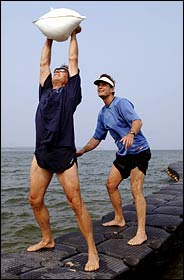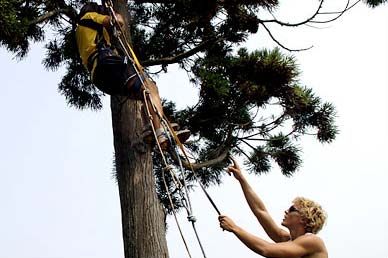NEW YORK TIMES, August 18, 2005
Taking Personal Training to Extremes
By STEFANI JACKENTHAL
The trainer Paul Frediani monitors the workout of his client, Jim Peterson, on a floating dock at Maidstone Beach in East Hampton. (Gordon M. Grant for The New York Times)THE first time Juris Kupris went on vacation with the De Paola family, two years ago, he flew with them via private jet to their family home in Jupiter Island, Fla. He spent his mornings road biking and running with Mike De Paola, 40, a real estate investor. In the afternoons Mr. Kupris coached Mike's wife, Brenda De Paola, 46, through exercises with resistance bands and stability balls. For the couple's 5-year-old twin daughters, he organized one-on-one soccer matches and other games.
Since then, Mr. Kupris has gone on half a dozen more vacations with the De Paolas. When the family is in Southampton, N.Y., he spends anywhere from 10 to 15 hours a week training Mr. De Paola. And he still finds time to conduct customized workouts for 25 other clients.
Mr. Kupris, 23, is one of the most sought-after personal trainers in New York City. This may be in part because he is friendly and attentive, and in part because of his self-taught expertise in body toning. But what really distinguishes Mr. Kupris is his willingness to go beyond the trainer's traditional job description. He meets clients at home or wherever they want to work out. For $125 an hour he'll become more like a brother, helping them with many other aspects of their lives. Part chef, part activity director, part children's camp counselor, he represents a new approach to personal training: the ultimate full-service fitness consultant.
Personal trainers who meet their clients in a gym for a 45- to 60-minute workout have become relatively commonplace. Some 6.2 million Americans hired one in 2004, an increase of more than 2 million over five years, according to a survey conducted by the International Health, Racquet & Sportsclub Association.
Now some clients are looking for more than just workouts. They want someone who becomes part of their life: who motivates them to try new activities, coaches them about what to eat and provides any other hand holding they need to get strong and stay that way. Graham Melstrand, the director of educational services for the American Council on Exercise, said in an e-mail message that this new demand has created "an opportunity for the well-qualified fitness professional to move beyond the traditional boundaries of fitness programming in the health club setting."
Trying unfamiliar activities, many trainers say, is an important part of the new training strategy.
"People respond to things out of the norm," said Paul Frediani, 52, a trainer who has 25 private clients but also works with members of the Equinox gym on Manhattan's Upper West Side. He once devised a week of beach training for a music producer that involved surfing, biking, running and dragging a sand-filled burlap bag. "They don't think of it as exercise," Mr. Frediani said.
And many trainers are finding it lucrative to keep away from gyms. It means they can avoid paying a percentage of their hourly fees to a health club. And it gives them opportunities to create new streams of revenue. Mr. Kupris's hourly rate is not extraordinarily high. (Other elite trainers have been known to charge $200 or even as much as $350.) But he also earns $500 to $1,000 a day on client trips, and is paid $60 a child for a summer camp that he runs in Southampton every Monday afternoon for the De Paola children and their friends. This fall Mr. Kupris, who is certified by the American Council on Exercise, plans to release four new exercise DVD's: workouts for hotel rooms, living rooms and playgrounds, as well as one for pregnant women.
Although he will not disclose his annual income, Mr. Kupris, a college dropout, has earned enough to buy a three-bedroom house in Southampton and a one-bedroom apartment on the Upper West Side.
Mike Gostigian, 40, a former Olympic pentathlete who trains private clients in New York, earned $14,000 for coaching one man through his final two weeks of preparation for a triathlon. In addition to supervising the client's meals - Mr. Gostigian had him to use chopsticks to slow his consumption - he coached him through yoga and strength training and spent many hours tweaking his swimming stroke and running technique. (His client finished the Mighty Hamptons triathlon - a 1.5-kilometer swim, a 40-kilometer bike ride and 10-kilometer run - in a respectable 2 hours 36 minutes.)
Last year five out-of-shape investment bankers paid Mr. Gostigian $4,500 to spend three days in Canada jump-starting their preparations for an adventure race. "I essentially created an Olympic training camp where they would train three times a day and listen to lectures in the morning and night," he said. The program included a morning trail run, during which he coached the men on body positioning and foot technique on tricky terrain, and in the afternoon, kayaking and rock climbing.
Courtney Barroll, 45, a New York City trainer, takes her clients to Central Park to run intervals on an uneven terrain and to do lunges up hills while holding dumbbells. This, she said, is "the best way to see fast results."
Her clients have liked her workouts enough to tell their friends. "What really changed things was working with a Fifth Avenue woman who wanted 'cocktail arms' for her sleeveless dresses," Ms. Barroll said. "Once she got them, I got flooded with calls from her friends who wanted the same. I got so busy that I needed to raise my rates."
Ms. Barroll's business grew further after some clients spread the word that she could not only strengthen their abs and biceps but also chat about CÚzanne or Picasso. (Her college degree is in art history.) Now her clientele includes socialites from Los Angeles, Miami and London. Three or four times a year, when they come to Manhattan for charity events, they book a week's worth of two-hour daily sessions, at $250 each.
Like Ms. Barroll many outside-the-gym trainers find their clients through word-of-mouth recommendations. Mr. Kupris met one client, Jeff Zucker, the president of NBC Universal Television Group, through his girlfriend, whom Mr. Zucker happened to use as a baby sitter.
Mike De Paola gets into position to work on an exercise under the direction of his personal trainer, Juris Kupris, in preparation for an adventure race that includes trail running, mountain biking, kayaking and rappelling. (Gordon M. Grant for The New York Times)Mr. Kupris, who grew up in Bolton, Conn., where his family ran a Latvian bread bakery, has been fit since he was a teenager. At that time he was a fledgling race car driver, and his training focused on cycling and on toughening up his deep abdominals and back muscles for the four-hour races. After high school he moved to Miami and worked as a fashion model. People there began asking him how he got into such good shape. Soon he began training people he had met in the fashion industry: strength training with them on the beach or running intervals through the streets of Miami. (He charged $100 an hour.) "People in fashion wanted long, sleek muscle tone, not overly muscular bodies," Mr. Kupris said. He changed his approach, increasing repetitions and shortening recovery time between exercises. Eventually, he moved to New York and became a full-time trainer.
To Mr. Kupris, the world is a gym, and ordinary objects are potential exercise gear. Three years ago, when he first started training Aviva Schneider, who was then pregnant, he used a kitchen towel to work her triceps. With two hands she held one end of the towel over her head while he pulled on the other end behind her back. Afterward, Mrs. Schneider said, her triceps twitched with exhaustion.
Mrs. Schneider, now 32, said that thanks to Mr. Kupris, "I got in the best shape of my life when I was pregnant." Mr. Kupris found more ways to help after Mrs. Schneider gave birth. "If the baby cried during a session, Mr. Kupris picked him up," she said. "It was like having a baby sitter and trainer all in one."
Working with people in private homes, backyards and traveling on family vacations can create an intimacy that can soften boundaries between trainer and client.
"Juris has become like a brother to me - the older brother when he's training me and younger when I'm teaching him about the stock market," Mr. De Paola said. "But he still charges me full rate."
When the two met in 2002 in Southampton, Mr. De Paola weighed 314 pounds and his 46-inch-waist trousers were snug. As part of a training regimen, he was speedwalking on the beach and tossing a 30-pound medicine ball at Mr. Kupris, who dodged the throws. Next came slow jogging, swimming and short bicycle rides, which gradually turned into two-hour trail runs and five-hour rides. After a year and a half Mr. De Paola had dropped 64 pounds. By last month he was down to 190 and a 32-inch waist.
Now Mr. Kupris is helping him prepare for an adventure race that will involve trail running, mountain biking, kayaking and rappelling.
Mr. De Paola said he will continue to depend on Mr. Kupris's coaching even after the race. "I'll drag him with me when I need to see property in Miami or Las Vegas," he said. "When I go on vacation and he's not there, it's hard for me to get motivated."


